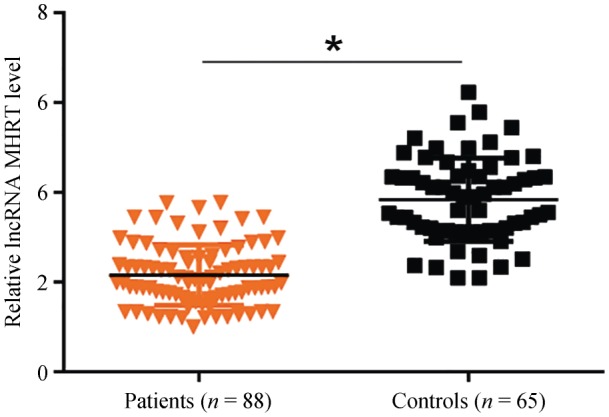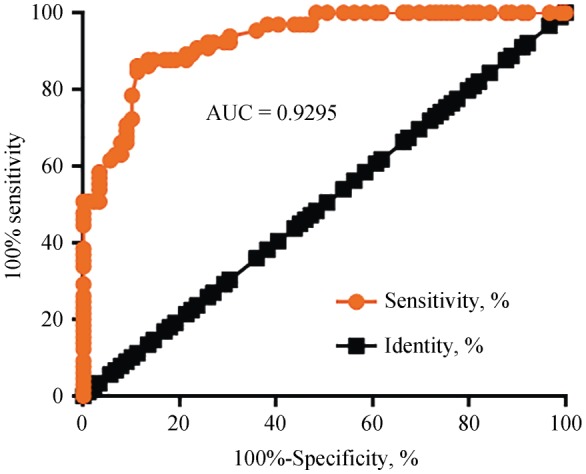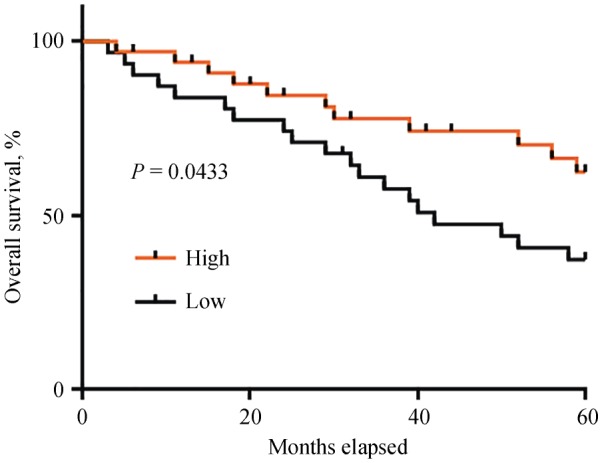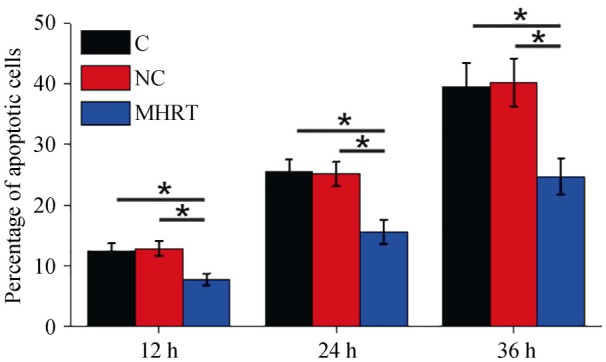Abstract
Background
It has been reported that lncRNA myosin heavy-chain-associated RNA transcripts (MHRT) can inhibit the apoptosis of cardiomyocytes. It is one of the major pathological changes leading to chronic heart failure.
Methods
The expression level of lncRNA MHRT was assessed by qRT-PCR. Diagnostic values of lncRNA MHRT for chronic heart failure were analyzed by ROC curve analysis. Cell apoptosis was detected by cell apoptosis assay.
Results
The results demonstrated that expression of lncRNA MHRT in plasma was down-regulated in patients with chronic heart failure compared to that in healthy people. Down-regulation of lncRNA MHRT distinguished chronic heart failure from healthy people. Over-expression of lncRNA MHRT inhibited the apoptosis of human cardiomyocyte cell line AC16 after H2O2 treatment. Follow-up study showed that chronic heart failure patients with lower expression levels of lncRNA MHRT had worse survival conditions compared to patients with higher expression levels of lncRNA MHRT.
Conclusion
We concluded that circulating lncRNA MHRT might serve as a diagnostic and prognostic marker for chronic heart failure treatment.
Keywords: Apoptosis, Cardiomyocytes, Chronic heart failure, lncRNA, MHRT
1. Introduction
The primary function of the heart is to maintain normal cardiac outputs.[1],[2] The heart failure caused by insufficient intracardiac filling pressures will lead to peripheral edema, pulmonary and symptoms of fatigue and dyspnea.[1],[2] The heart failure at a later stage in patients who have heart disease is one of the leading causes of death all over the world.[3] Accumulative studies have revealed that heart failure is responsible for more than one out of nine deaths in the United States.[4] A large number of chronic heart failure patients could die within 5 years after diagnosis.[4] Therefore, heart failure has become a major public health problem worldwide.[5]
Genetic factors have been demonstrated to play central roles in the pathogenesis of heart failure.[6] However, the molecular mechanisms of the development and progression of heart disease largely remain unknown.[6] Long non-coding RNAs (lncRNAs) are a group of non-coding RNAs that have transcripts of greater than 200 nucleotides in length.[7] LncRNAs participate in biological procedures in the form of RNAs.[7] Previous studies have shown that lncRNAs play pivotal roles in various human diseases including heart diseases.[8]–[11] A recent study demonstrated that lncRNA myosin heavy-chain-associated RNA transcripts (MHRT) could inhibit the apoptosis of cardiomyocytes, which is one of the major pathological changes in chronic heart failure.[12] Our study showed that down-regulation of lncRNA MHRT could serve as a diagnostic and prognostic marker for chronic heart failure. We also found that over-expression of lncRNA MHRT inhibited the apoptosis of cardiomyocytes.
2. Methods
2.1. Patients and cell line
A total of 88 patients with chronic heart failure and 65 healthy people were recruited from the Second Affiliated Hospital at Xi'an Jiaotong University between January 2011 and May 2013. Patient inclusion criteria were as following: (1) patient was diagnosed as chronic heart failure for the first time; (2) patients have complete medical record; (3) patients fully understood the experimental principle and signed the informed consent; and (4) patients have completed the treatment and 5-year follow-up. Exclusion criteria were as following: (1) patients were having other medical conditions; and (2) patients died of other causes during follow-up. The patient group included 50 males and 38 females, with the age ranged from 41- to 72 years- and a mean age of 54.5 ± 6.6 years. The control group included 40 males and 25 females, with the age ranged from 40- to 70-years and a mean age of 53.7 ± 5.9 years. These groups had similar age and gender distributions. The study was approved by the ethics committee of the Second Affiliated Hospital of Xi'an Jiaotong University.
Cells of human cardiomyocyte cell line AC16 were purchased from EMD Millipore, USA. According to the manufacturer's instructions, cells were cultivated with Dulbecco's modified Eagle's medium (DMEM) supplemented with 12% fetal bovine serum (FBS) and 1% penicillin and streptomycin in an incubator (37°C, 5% CO2).
2.2. Specimens and follow-up
Blood samples were collected from each participant on the day of admission. Plasma was prepared from blood using conventional approach. All patients were followed up for 5 years to record survival conditions.
2.3. qRT-PCR
The GenElute™ Total RNA Purification Kit (Sigma-Aldrich) was used to extract total RNAs from the plasma. Following reverse transcription using the RevertAid RT Reverse Transcription Kit (Thermo Fisher Scientific), qRT-PCR was conducted using the SYBR® Green Quantitative RT-qPCR Kit (Sigma-Aldrich) on a CFX96 Touch™ Real-Time PCR Detection System (Bio-Rad) with the following conditions: 95°C for 1 min, followed by 40 cycles of 95°C for 40 s and 56.5°C for 45 s. Primers of lncRNA MHRT and the endogenous control β-actin were designed and synthesized by GenePharma (Shanghai, China). Ct values were assessed and normalized using the 2−ΔΔCT method.
2.4. Cell transfection
Vectors expressing lncRNA MHRT were designed and synthesized by GenePharma (Shanghai, China). Transfections were performed using the lipofectamine 2000 reagent with vectors at a dose of 15 nmol/L, and the empty vector was used as a negative control. Expression of lncRNA MHRT was detected 24 h after transfection and the over-expression rate of lncRNA MHRT above 250% was observed.
2.5. Cell apoptosis assay
Cell apoptosis was detected by cell apoptosis assay after 24 h of transfection. Briefly, cells were harvested and suspended to a cell density of 4 × 104 cells/mL. Cells were transferred to a 6-well plate with 10 mL cell suspension in each well. 150 µmol/L H2O2 was added into each well. Cells were cultivated for 12, 24 and 36 h. Cells were then subjected to 0.25% trypsin digestion. Cell apoptosis was detected by flow cytometry after propidium iodide (PI) and Annexin V-FITC (Dojindo, Japan) staining.
2.6. Statistical analysis
All experiments were performed three times and data were expressed as mean ± SD. All data were processed using the Graphpad Prism 6 software. Diagnostic values of plasma lncRNA MHRT for chronic heart failure were analyzed by ROC curve analysis with chronic heart failure patients as positive cases and healthy people as negative cases. Patients were divided into high (n = 46) and low (n = 42) lncRNA MHRT expression groups according to the Youden index. The Kaplan-Meier method was used to draw the survival curves for both groups, followed by the comparison of survival curves using the log-rank test. Data comparisons were performed by unpaired t-test (between the two groups) or one-way analysis of variance followed by LSD test (among multiple groups). P < 0.05 represented a statistical significance.
3. Results
3.1. Expression of lncRNA MHRT was down-regulated in patients with chronic heart failure
Expression of lncRNA MHRT in 88 chronic heart failure patients and 65 healthy people were detected by qRT-PCR. Compared with healthy people, the expression levels of lncRNA MHRT plasma were significantly lower in chronic heart failure patients (P < 0.05) (Figure 1).
Figure 1. Plasma level of lncRNA MHRT was down-regulated in patients with chronic heart failure than that in healthy people.

(*P < 0.05). MHRT: myosin heavy-chain-associated RNA transcripts.
3.2. Down-regulation of lncRNA MHRT distinguished chronic heart failure patients from healthy people
Diagnostic values of plasma lncRNA MHRT for chronic heart failure were analyzed by ROC curve analysis with chronic heart failure as positive cases and healthy people as negative cases. As shown in Figure 2, the area under the curve was 0.9295, with the standard error of 0.01921 and 95% confidence interval of 0.8918–0.9617 (P < 0.0001).
Figure 2. Down-regulation of lncRNA MHRT distinguished chronic heart failure from healthy people.

ROC curve analysis showed that down-regulation of lncRNA MHRT distinguished chronic heart failure from healthy people. AUC: area under the curve; MHRT: myosin heavy–chain-associated RNA transcripts.
3.3. Lower expression levels of lncRNA MHRT were significantly correlated with worse survival conditions
Patients were divided into high (n = 46) and low (n = 42) lncRNA MHRT expression groups according to the Youden index. Kaplan-Meier method was used to draw the survival curves for both groups, followed by comparison of survival curves using log-rank test. As shown in Figure 3, patients in high-level group showed significantly higher overall survival rate compared with those in low-level group.
Figure 3. Lower expression levels of lncRNA MHRT were significantly correlated with worse survival conditions.

Analysis of survival curves revealed that patients in the high-level group showed significantly higher overall survival rate compared with patients in the low-level group. MHRT: myosin heavy chain associated RNA transcripts.
3.4. Over-expression of lncRNA MHRT inhibited the apoptosis of cardiomyocytes
Cell apoptosis assay data revealed that over-expression of lncRNA MHRT significantly inhibited apoptosis of AC16 cells, compared to the control (C) and negative control (NC) groups after H2O2 treatment.
Figure 4. Over-expression of lncRNA MHRT inhibited the apoptosis of cardiomyocytes after H2O2 treatment.

Cell apoptosis assay data showed that over-expression of lncRNA MHRT led to significantly inhibited apoptosis of AC16 cells after H2O2 treatment (*P < 0.05). C: control; MHRT: myosin heavy-chain-associated RNA transcripts; NC: negative control.
4. Discussion
Previous study has reported that lncRNA MHRT can inhibit the apoptosis of cardiomyocytes,[12] indicating the potential role of lncRNA MHRT in the progression of chronic heart failure. Our present study further confirmed the role of lncRNA MHRT in inhibiting the apoptosis of cardiomyocytes under oxidative stress. Our clinical study also showed that lncRNA MHRT had diagnostic and prognostic values for chronic heart failure treatment.
The development of chronic heart failure is accompanied by the dysregulation of a large set of lncRNAs,[13] indicating the critical roles of lncRNAs in this disease. lncRNA LIPCAR has been demonstrated to participate in disease development.[14] Altered expression of lncRNAs has been shown to predict the survival of patients.[14] There are also lncRNAs showing protective effects on the heart of chronic heart failure patients and can serve as potential therapeutic targets for this disease.[15] Our present study showed that plasma circulating lncRNA MHRT existed in both chronic heart failure patients and healthy people. The plasma levels of lncRNA MHRT were significantly higher in chronic heart failure patients than that in healthy people. Therefore, plasma circulating lncRNA MHRT may serve as a diagnostic biomarker for chronic heart failure.
Chronic heart failure causes an unacceptably high mortality rate.[3] The identification of novel prognostic maker is of great clinical values for the follow-up care and treatment of chronic heart failure patients. Our present study showed that the overall survival rate of patients in the high-level lncRNA MHRT group was significantly higher than that in patients in the low-level lncRNA MHRT group. Therefore, lncRNA MHRT may serve as a promising prognostic biomarker for chronic heart failure.
Apoptosis of cardiomyocytes under oxidative stress contributes to the development of heart failure.[16] The inhibition of cardiomyocytes apoptosis and treatment with exogenous cardiomyocytes have been proved to be potential therapeutic target for heart failure. A recent study reported that lncRNA MHRT inhibited the apoptosis of cardiomyocytes after H2O2 treatment.[12] Our study further confirmed the protective role of lncRNA MHRT in cardiomyocytes under oxidative stress. Up-regulation of lncRNA MHRT could improve the conditions of chronic heart failure by inhibiting the apoptosis of cardiomyocytes.
In conclusion, lncRNA MHRT is down-regulated in chronic heart failure patients and dysregulated lncRNA MHRT has diagnostic and prognostic values. Over-expression of lncRNA MHRT inhibited the apoptosis of cardiomyocytes. Therefore, Up-regulation of lncRNA MHRT may improve the conditions of chronic heart failure patients.
Acknowledgments
The authors declare that they have no competing interests. All authors have read and approved the final manuscript.
References
- 1.Hoffman TM. Chronic heart failure. Pediatr Crit Care Med. 2016;17(8_Suppl):S119–S123. doi: 10.1097/PCC.0000000000000755. [DOI] [PubMed] [Google Scholar]
- 2.Morrissey RP, Czer L, Shah PK. Chronic heart failure. Am J Cardiovasc Drugs. 2011;11:153–171. doi: 10.2165/11592090-000000000-00000. [DOI] [PubMed] [Google Scholar]
- 3.Pocock S J, Wang D, Pfeffer M A, et al. Predictors of mortality and morbidity in patients with chronic heart failure. Eur Heart J. 2006;27:65–75. doi: 10.1093/eurheartj/ehi555. [DOI] [PubMed] [Google Scholar]
- 4.Benjamin EJ, Blaha MJ, Chiuve SE, et al. Heart disease and stroke statistics—2017 update: a report from the American Heart Association. Circulation. 2017;135:e146. doi: 10.1161/CIR.0000000000000485. [DOI] [PMC free article] [PubMed] [Google Scholar]
- 5.Roger VL, Go AS, Lloyd-Jones DM, et al. Heart disease and stroke statistics—2011 update: a report from the American Heart Association. Circulation. 2011;123:e18–e209. doi: 10.1161/CIR.0b013e3182009701. [DOI] [PMC free article] [PubMed] [Google Scholar]
- 6.Yang J, Xu W, Hu S. Heart failure: advanced development in genetics and epigenetics. Biomed Res Int. 2015;2015:352734. doi: 10.1155/2015/352734. [DOI] [PMC free article] [PubMed] [Google Scholar]
- 7.Mercer TR, Dinger ME, Mattick JS. Long non-coding RNAs: insights into functions. Nat Rev Genet. 2009;10:155–159. doi: 10.1038/nrg2521. [DOI] [PubMed] [Google Scholar]
- 8.Gibb EA, Brown CJ, Lam WL. The functional role of long non-coding RNA in human carcinomas. Mol Cancer. 2011;10:38. doi: 10.1186/1476-4598-10-38. [DOI] [PMC free article] [PubMed] [Google Scholar]
- 9.Shi X, Sun M, Liu H, et al. Long non-coding RNAs: a new frontier in the study of human diseases. Cancer Lett. 2013;339:159–166. doi: 10.1016/j.canlet.2013.06.013. [DOI] [PubMed] [Google Scholar]
- 10.Wapinski O, Chang HY. Long noncoding RNAs and human disease. Trends Cell Biol. 2011;21:354–361. doi: 10.1016/j.tcb.2011.04.001. [DOI] [PubMed] [Google Scholar]
- 11.Vausort M, Wagner DR, Devaux Y. Long noncoding RNAs in patients with acute myocardial infarction. Circ Res. 2014;115:668–677. doi: 10.1161/CIRCRESAHA.115.303836. [DOI] [PubMed] [Google Scholar]
- 12.Zhang J, Gao C, Meng M, Tang H. Long noncoding RNA MHRT protects cardiomyocytes against H2O2-induced apoptosis. Biomol Ther (Seoul) 2016;24:19–24. doi: 10.4062/biomolther.2015.066. [DOI] [PMC free article] [PubMed] [Google Scholar]
- 13.Greco S, Zaccagnini G, Perfetti A, et al. Long noncoding RNA dysregulation in ischemic heart failure. J Transl Med. 2016;14:183. doi: 10.1186/s12967-016-0926-5. [DOI] [PMC free article] [PubMed] [Google Scholar]
- 14.Kumarswamy R, Bauters C, Volkmann I, et al. Circulating long noncoding RNA, LIPCAR, predicts survival in patients with heart failure. Circ Res. 2014;114:1569–1575. doi: 10.1161/CIRCRESAHA.114.303915. [DOI] [PubMed] [Google Scholar]
- 15.Ounzain S, Pedrazzini T. Long non-coding RNAs in heart failure: a promising future with much to learn. Ann Transl Med. 2016;4:298. doi: 10.21037/atm.2016.07.13. [DOI] [PMC free article] [PubMed] [Google Scholar]
- 16.Münzel T, Gori T, Keaney JF, Jr, et al. Pathophysiological role of oxidative stress in systolic and diastolic heart failure and its therapeutic implications. Eur Heart J. 2015;36:2555–2564. doi: 10.1093/eurheartj/ehv305. [DOI] [PMC free article] [PubMed] [Google Scholar]


